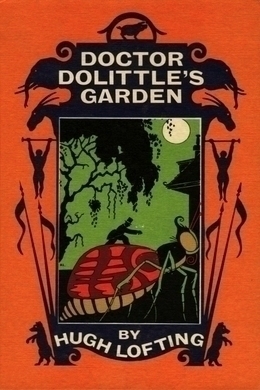
-
EPUB 2.52 MB
-
Kindle 2.59 MB
-
Support epubBooks by making a small $2.99 PayPal donation purchase.
This work is available for countries where copyright is Life+70 or less.
Description
Doctor Dolittle’s Garden is structurally the most disorganised of Hugh Lofting’s Doctor Dolittle books. The first part would fit very well into Doctor Dolittle’s Zoo, which this book follows. The rest of the book forms a reasonably coherent narrative. Doctor Dolittle’s assistant, Tommy Stubbins, reports on Professor Quetch, curator of the Dog Museum in the Home for Crossbred Dogs. Meanwhile, the doctor has learnt insect languages and hears ancient tales of a giant race of insects. Fascinated, the doctor plans a voyage to find them — but before he does so, one arrives in his garden.
225 pages with a reading time of ~3.50 hours (56297 words), and first published in 1927. This DRM-Free edition published by epubBooks, 2014.
Community Reviews
There are currently no other reviews for this book.
Excerpt
I suppose there is no part of my life with the Doctor that I, Thomas Stubbins, look back on with more pleasure than that period when I was Assistant Manager of the Zoo.
We had come, as I have told you elsewhere, to call that part of the Doctor’s garden “Animal Town.” One of my greatest difficulties was in keeping down the membership in the various clubs and institutions. Because of course a limit had to be put on them. The hardest one to keep in check was the Home for Crossbred Dogs. Jip was always trying to sneak in some waif or stray after dark; and I had to be quite stern and hard-hearted if I did not want the mongrels’ club disorganized by over-crowding.
But while the Doctor and I were agreed that we must keep a fixed limit on all memberships, we encouraged development, expansion and new ideas of every kind on the part of the animals themselves that would help to make Animal Town a more interesting and more comfortable place to live in. Many of these were extremely interesting. Among them was the Dog Museum.
For many years the Doctor had had a museum of his own. This was a large room next to the study where bones, mineral specimens and other natural-history things were kept. There is an old saying: Imitation is the sincerest form of flattery. A natural interest in bones often led the dogs to contemplate this display and finally to start a museum of their own.
This was helped to some extent by a peculiar dog who had some months before become a member of the club. The peculiarity of his character was that he had an inborn passion for collecting. Prune-stones, umbrella-handles, door-knobs–there was no end to the variety of his collections. He always maintained that his prune-stone collection was the largest and finest in the country.
This dog’s name was Quetch. He was a great friend of Toby, who had first introduced him and put him up for membership at the club. He was a good second to Toby in upholding the rights of the small dogs at the club-house and seeing that they didn’t get bullied out of any of their privileges. In fact Blackie and Grab always said that the small dogs, with Toby and Quetch to champion them, bossed the club a good deal more than they had any business to. Well, Quetch it was (he was a cross between a West Highland terrier and an Aberdeen) who first suggested the idea that the Mongrels’ Club should have a museum of its own. With his passion for collecting, he was probably counting on getting the job of museum curator for himself-which he eventually did. The House Committee met in solemn council to discuss the pros and cons and ways and means. The idea was finally adopted by a large majority vote and a section of the gymnasium was screened off to form the first headquarters of the museum.
Quetch (he was always called “Professor” by the other members of the club)–Professor Quetch, besides being a keen scientist, had a genius for organization almost as good as the white mouse’s. And even he could not find fault with the general enthusiasm with which the Dog Museum was supported, and contributed to, by the members of the club. There was hardly a dog in the Home who didn’t turn to collecting and bringing in material. And Quetch the curator had his paws more than full receiving and arranging the continuous flow of specimens of every kind that poured in.
The Museum was not confined to natural history. It was also an archæological or historical museum. The bones department was perhaps the largest. Personally, I don’t think that any student of comparative anatomy would have found it scientifically very helpful. For the bones were mostly beef, mutton and ham bones.
But not all. There were fish bones. In fact there was one whole fish, which Professor Quetch proudly ordered me to label, “The Oldest Fish in the World” I could well believe it was. Blackie the retriever had dug it up–from the place where some one had carefully buried it a long time ago. Its odour was so far-reaching that the members of the Badgers’ Tavern (which was at least a hundred yards away from the Home for Crossbred Dogs) sent in a request that something be done about it. They said that while they were not usually over-sensitive to smells, this one kept them awake at night. Professor Quetch was very much annoyed and sent a message back to the badgers that they were a lot of low-brow, meddlesome busybodies who didn’t appreciate science. But some of the Doctor’s neighbours across the street also complained; and the “oldest fish in the world” had to go–back to the garbage heap.
